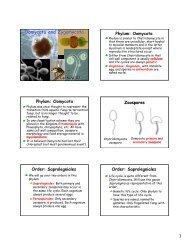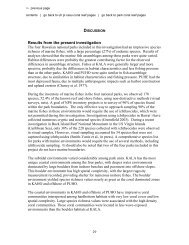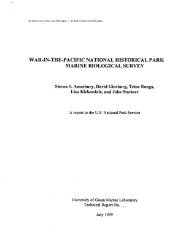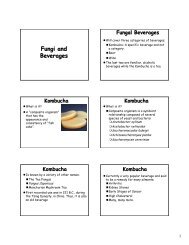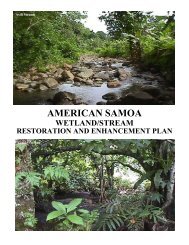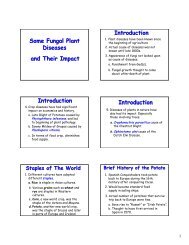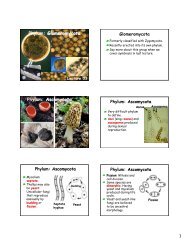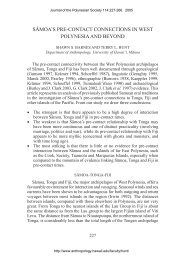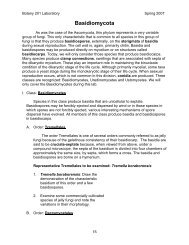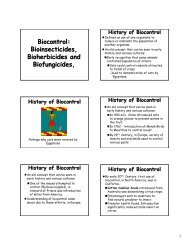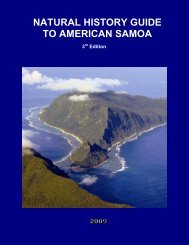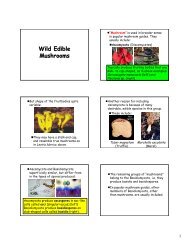Download - University of Hawaii at Manoa Botany Department
Download - University of Hawaii at Manoa Botany Department
Download - University of Hawaii at Manoa Botany Department
Create successful ePaper yourself
Turn your PDF publications into a flip-book with our unique Google optimized e-Paper software.
Intern<strong>at</strong>ional Associ<strong>at</strong>ion <strong>of</strong> Veget<strong>at</strong>ion Science<br />
47th Annual Symposium in Hawai`i<br />
Post-Conference Field Trip Guide<br />
Prepared by<br />
Dieter Mueller-Dombois & Kim Bridges<br />
<strong>University</strong> <strong>of</strong> Hawai`i <strong>at</strong> <strong>Manoa</strong><br />
Honolulu, HI 96822<br />
July 2004
Mauna Kea Veget<strong>at</strong>ion Pr<strong>of</strong>i le (East Slope, Summit to above Hilo)
Haleakala Veget<strong>at</strong>ion Pr<strong>of</strong>i le (North-East Slope)
Metrosideros stand structure models<br />
(m<strong>at</strong>ure stand)<br />
(after canopy dieback)
Extreme Rainfall Months <strong>at</strong> Hilo Airport
Maui, July 24-26, 2004<br />
S<strong>at</strong>urday, July 24 West Maui Trip (during afternoon)<br />
• The Post-Conference Group (34 according to the l<strong>at</strong>est count) leaves Kailua-Kona Airport <strong>at</strong> 12:22 PM<br />
with HA 177.<br />
• Arrival in Kahului, Maui <strong>at</strong> 12:51 PM. Airport pick-up by bus from Akaina Tours [(808) 879-2828]. It<br />
also carries the entire luggage. Transfer to coach with the entire luggage after arrival, I estim<strong>at</strong>e will<br />
take 40-50 minutes.<br />
• Next we drive from the Airport to West Maui through Wailuku to `Iao Valley St<strong>at</strong>e Park and Kapaniwai<br />
Heritage Garden. We may spend there 1 to 2 hours, and then drive back to Kahului to get to the Maui<br />
Seaside Hotel [(808) 877-3311] after check-in time and spend the rest <strong>of</strong> the day and the night there.<br />
Sunday, July 25 East Maui Upland Tour, Haleakalā Mountain<br />
• 7:30 AM depart from Seaside Hotel. Drive to Makawao-Pukalani and drop <strong>of</strong>f signed Permits for all<br />
participants <strong>at</strong> N<strong>at</strong>ure Conservancy Offi ce. (Since this is a Sunday, all the permitting procedure has to<br />
be done before. DMD will clarify this with P<strong>at</strong>ti Welton or Lloyd Loope). From Pukalani we drive up<br />
on Haleakalā Highway to Hosmer Grove.<br />
• 9:30 AM hike from Hosmer Grove via conifer plant<strong>at</strong>ion area to Waikamoi N<strong>at</strong>ure Reserve and down<br />
Fish and Wildlife Transect 3. Upper montane n<strong>at</strong>ive Acacia koa – Metrosideros – Dryopteris cloud<br />
forest. Described in “Veget<strong>at</strong>ion <strong>of</strong> the Wet Windward Slope <strong>of</strong> Haleakalā” in Pac. Sci. 46: 207 as Unit<br />
B3: Metrosideros-Sadleria ecotone community between 1750-1950 m. See also Figure 3: 203, upper<br />
montane zone.<br />
• 1:30 PM Lunch from pack lunch (kept in bus) <strong>at</strong> Hosmer Grove.<br />
• 2:30 PM Stop <strong>at</strong> Park Headquarters (2135 m). [Fee waver]<br />
• 3:00 PM Stop <strong>at</strong> Halemau`u Trail <strong>at</strong> 8000 feet elev<strong>at</strong>ion (2440 m). Walk along trail for about 100 m<br />
to a Sandalwood bush (Santalum haleakalae). This is Unit C1: Subalpine scrub community Dubautia<br />
– Sophora in Pac. Sci. 46: 202-207, from 2000-2700 m elev<strong>at</strong>ion (9000 feet).<br />
• 4:00 PM Stop <strong>at</strong> Red Hill, Summit <strong>of</strong> Haleakalā, 3057 m (10,023 feet). Alpine stone desert.<br />
• 4:30 PM Stop <strong>at</strong> Silversword enclosure, near Kalahaku Overlook 2825 m (9,324 feet). Here, we make<br />
a short trail hike along contour into tropical upper subalpine scrub with sc<strong>at</strong>tered n<strong>at</strong>ive bunchgrass,<br />
Deschampsia nubigena, Dubautia menziesii shrubs, and silversword individuals (Argyroziphium<br />
sandwicensis spp. macrocephalum) in various life stages.<br />
• 5:30 PM Return to Maui Seaside Hotel in Kahului for second overnight stay.<br />
Monday, July 26 East Maui Lowland Rainforest and Historic Dieback Area<br />
• 7:30 AM Start from Maui Seaside Hotel after check-out and luggage is stored on coach. Lunch<br />
packages should be handed out to each participant to carry in pack sack. Drive to Pa`ia EMI Offi ce to<br />
get key and collect permits. Name list must be <strong>at</strong> EMI Offi ce one week before.<br />
• 8:15 AM Continue on Hana Highway via Kailua to Papa`a`ea Reservoir and g<strong>at</strong>e to Spreckle’s Trail (a<br />
Jeep Road).<br />
• 9:00 AM Enter through g<strong>at</strong>e on foot with EMI key and walk up 3 km on Spreckle’s Trail past Reservoirs<br />
to base <strong>of</strong> Eucalyptus robusta forest (planted in early 1930s). From base <strong>of</strong> eucalypt forest hike<br />
along blue fl agged trail, 1 km up gentle slope through sections <strong>of</strong> Melaleuca forest to edge <strong>of</strong> historic<br />
Metrosideros dieback area.<br />
• 12:00 Lunch <strong>at</strong> forest edge (dieback boundary). See “Veget<strong>at</strong>ion <strong>of</strong> Wet Windward Slope” Pac. Sci.<br />
46: 203-204 Unit A1 Metrosideros-Sphenomeris (Odontosoria) dieback area with stunted Metrosideros<br />
scrub islands and old big-diameter broken-down tree skeletons. Note Melaleuca invasion. See also
story on “Maui forest trouble” by Alan Holt on www.botany.hawaii.edu/pabitra.<br />
• 1:00 PM Hike back to parked coach.<br />
• 3:00 PM Back in coach, and <strong>of</strong>f to Kahului Airport for l<strong>at</strong>e afternoon fl ight to Lihue, Kaua`i (4:00 PM <strong>at</strong><br />
Airport).<br />
• Departure from Maui <strong>at</strong> 5:32 PM on HA 549V. Arrives HNL 6:06 PM, continues to Kaua`i <strong>at</strong> 6:45 PM.<br />
Arrival on Kaua`i <strong>at</strong> 7:22 PM. Received there <strong>at</strong> Lihue Airport by Kaua`i Island Tours.<br />
Plant Species on the Windward Transect <strong>of</strong> Haleakalā, Maui<br />
Acacia koa (Fabaceae), end.<br />
Adenophorus tripinn<strong>at</strong>ifi dus (Grammitidaceae), end., slender creeping rhizomes P: 37<br />
Adenophorus montanus, end. renamed A. tamariscinus var. montanus, thick rhizomes P: 37<br />
Adenophorus pinn<strong>at</strong>ifi dus, end. common, frond tapering <strong>at</strong> both ends, P: 40<br />
Adenophorus hymenophylloides, end. hanging fronds, palai huna (hidden fern) P: 37<br />
Adenophorus tamariscinus, end. epiphyte, thick rhizome, fronds can be bottle brush form P: 37<br />
Ager<strong>at</strong>ina adenophora, n<strong>at</strong>. (Asteraceae), Maui pāmakani W: 254<br />
Agrostis sandwicensis, end. (Poaceae) W: 1492<br />
Alyxia oliviformis, end. (Apocynaceae), maile W: 214<br />
Andropogon virginicus, n<strong>at</strong>. (Poaceae), broomsedge, fi rst coll. 1924 W: 1497<br />
Anthoxanthum odor<strong>at</strong>um, n<strong>at</strong>. (Poaceae), sweet vernal grass, fi rst coll. 1907 W: 1498<br />
Antidesma pl<strong>at</strong>yphyllum, end. (Euphorbiaceae), hame, W: 600<br />
Argyroxiphium sandwicense ssp. macrocephalum, end. (Asteraceae) ahinahina W: 261<br />
Asplenium trichomanes, ind. (Aspleniaceae), `oāli`i, small, caespitose, narr. fronds, P: 61<br />
Asplenium lobul<strong>at</strong>um, ind. pi`ipi`i lau manamana, dissected lvs, one pinn<strong>at</strong>e P: 64<br />
Asplenium acumin<strong>at</strong>um, end. lola, bi-pinn<strong>at</strong>e, P: 56<br />
Asplenium adiantum-nigrum, ind. `iwa`iwa, P: 59<br />
Asplenium normale, ind. blades 1-pinn<strong>at</strong>e, narrow linear-lanceol<strong>at</strong>e, prolifer<strong>at</strong>ion <strong>at</strong> frond tops, P: 61, 70<br />
Asplenium polyodon, ind. pūnana manu (bird nest) P: 72<br />
Asplenium fragile, end. renamed A. peruvianum var. insulare P: 75<br />
Astelia menziesiana end. (Liliaceae), kaluaha, W: 1460<br />
Athyrium microphyllum, end. (Athyriaceae), ākōlea, P: 77<br />
Athyrium sandwichianum, end. renamed Diplazium sandwichianum (Athyriaceae), hā`i` o, pohole (on Maui),<br />
P: 124<br />
Broussaisia arguta, end. (Hydrangeaceae) kanawao, pu`ahanui W: 794<br />
Carex allig<strong>at</strong>a, end. (Cyperaceae) W: 1388<br />
Carex wahuensis, end. W: 1392<br />
Centella asi<strong>at</strong>ica, n<strong>at</strong>. (Apiaceae), pohakula W: 201<br />
Cerastium fontanum ssp.triviale, n<strong>at</strong>. (Caryophyllaceae), mouse ear chickweed, W: 504<br />
Cheirodendrum trigynum end. (Araliaceae), `ōlapa W: 227<br />
Cibotium glaucum, end. (Dicksoniaceae) hāpu`u pulu P: 85<br />
Clermontia kakeana end. (Campunalaceae) W: 429<br />
Clermontia arborescens ssp. waihiae end. `ōhā wainui, W: 426<br />
Clermontia grandifl ora ssp. grandifl ora end. W: 429, long fl ower stalks<br />
Clidemia hirta n<strong>at</strong>. (Melastom<strong>at</strong>aceae), Koster’s curse W: 906<br />
Commelina diffusa n<strong>at</strong>. (Commelinaceae), honohono W: 1378<br />
Coniogramme pilosa end. (Ptreridaceae), lo`ulu, P: 99, base pinnae forked
Conyza bonariensis n<strong>at</strong>. (Asteraceae), lani wela, hairy horseweed, W: 285<br />
Coprosma ernodeoides end. (Rubiaceae), kūkaenēnē W: 1125<br />
Coprosma montana end. dioecious W: 1128<br />
Coprosma pubens end. W: 1129, hairs in line<br />
Coprosma ochracea end. W: 1127<br />
Ctenitis rubiginosa end. (Dryopteridaceae) renamed: Nothoperanema rubiginosa, stems very hairy P: 194<br />
Ctenitis l<strong>at</strong>ifrons end. ākolea, P: 101<br />
Cuphea arthagenensis n<strong>at</strong>. (Lythraceae), tarweed, W: 867<br />
Cyanea acule<strong>at</strong>ifl ora end. (Campanulaceae), W: 438, lg. lvs. serr<strong>at</strong>e<br />
Cyanea kunthiana end. W: 450, lg. lvd, entire<br />
Cyperus halpan n<strong>at</strong>. (Cyperaceae) W: 1397<br />
Cyrtandra hashimotoi end. (Gesneriaceae) W: 757, hairy lvs. & calyx<br />
Cyrtandra pl<strong>at</strong>yphylla end. `ilinia, W: 772, the common broad, wd,. serr<strong>at</strong>e form<br />
Dactylis glomer<strong>at</strong>a n<strong>at</strong>. (Poaceae), cocks foot W: 1521<br />
Deschampsia nubigena end. (Poaceae) W: 1524<br />
Dicranopteris linearis ind. (Gleicheniaceae) uluhe P: 115<br />
Digitaria sp. n<strong>at</strong>. (Poaceae) crabgrass W: 1529<br />
Diplopterygium pinn<strong>at</strong>um ind. (Gleicheniaceae) (formerly Hicriopteris, uluhe lau nui P: 127<br />
Dodonaea viscosa ind. (Sapindaceae), `a`ali`i W: 1227<br />
Dryopteris glabra var. nuda (Dryopteridaceae) kīlau, P: 140, 145<br />
Dryopteris tetrapinn<strong>at</strong>a, 4-pinn<strong>at</strong>e, restricted to E. Maui’s rainforest, very large (up to 3 m long) scaly fronds,<br />
P: 149<br />
Dryopteris acutidens, renamed D. unident<strong>at</strong>a var. palcana P: 149<br />
Dryopteris fusco-<strong>at</strong>ra P: 152, 1i1i, reddish brown, close to D. wallichiana but blade more chartaceous<br />
Dryopteris hawaiiensis P: 146 & pl<strong>at</strong>e: 143, hairy frond<br />
Dryopteris unident<strong>at</strong>a `akole, P: 148, has two varieties: paleasea & unident<strong>at</strong>a<br />
Dryopteris subbipinn<strong>at</strong>a P: 147, fronds up to 2 m on erect rhizomes, usually associ<strong>at</strong>ed with D. wallichana<br />
Dryopteris wallichiana ind. P: 152, `i`o nui, laukahi, opposite pinnae, denser than D. fusco-<strong>at</strong>ra<br />
Dryopteris glabra P: 143, less hairy frond but <strong>of</strong>ten confused with D. hawaiiensis<br />
Dubautia menziesii (Asteraceae), W: 300, hispid, revolute<br />
Elaphoglossum hirtum ind. (Elaphoglossaceae), renamed E. paleaecum, P: 158, 159, rough surface<br />
Elaphoglossum pelludicum, `ēkaha `ula hoe a Maui, P: 159<br />
Elaphoglossum al<strong>at</strong>um, hoe a Maui (Maui’s paddle), P: 155, `ēkaha, glabrous<br />
Elaphoglossum crassifolium, `ēkaha or hoe a Maui, P: 156-157<br />
Elaphoglossum wawrae, laukahi, `ēkaha, P: 160, Pl<strong>at</strong>e 159, v. dimorphic, sterile vs. fertile<br />
Epilobium billardierianum spp. cinereum n<strong>at</strong>. (Onagraceae) willoq herb W: 995, lvs. bluish green<br />
Erechtites valerianifolia n<strong>at</strong>. (Asteraceae) fi reweed W: 314<br />
Fragaria chiloensis spp. sandwicensis ind. (Rosaceae) `ōhelo papa, lower surface densely silky W: 1103<br />
Freycinetia arborea ind. (Pandanaceae) `ie, `ie`ie W: 1428<br />
Gahnia gahniiformis ind. (Cyperaceae) W: 1409<br />
Geranium cune<strong>at</strong>um spp. tridens (Geraniaceae) hina hina end. W: 731<br />
Grammitis hookeri n<strong>at</strong>. (Grammitidaceae) māku`e lau li`i (small lvd. māku`e), P: 165<br />
Grammitis tenella kolokolo, P: 164<br />
Hedyotis hillebrandii end. (Rubiaceae) manono, W: 1143, fl owers & fruits below term. lvs. on branches<br />
Hedyotis terminalis manono, fruits terminal (formerly Gouldia) W: 1154<br />
Holcus lan<strong>at</strong>us n<strong>at</strong>. (Poaceae), common velvet grass, fi rst coll. 1909 W: 1551
Huperzia phyllantha ind. (Lycopodiaceae), wāwae `iole (r<strong>at</strong>’s foot), P: 255<br />
Huperzia serr<strong>at</strong>a ind. (lvs. serr<strong>at</strong>e) P: 264<br />
Hypochoeris radiv<strong>at</strong>a n<strong>at</strong>. (Asteraceae), hairy c<strong>at</strong>’s ear, fi rst coll. on Maui 1909 W: 327<br />
Ilex anomala ind. (Aquifolaceae) kawa`a, `aiea W: 222<br />
Juncus planifolius n<strong>at</strong>. (Juncaceae), bog rush, W: 1448<br />
Juncus effuses n<strong>at</strong>. Japanese m<strong>at</strong> rush W: 1453<br />
Korthalsella complan<strong>at</strong>a ind. (Viscaceae) hulumoa W: 1338<br />
Kyllinga brevifolia n<strong>at</strong>. (Cyperaceae) kili `o`opu, W: 1412<br />
Labordia hedyosmifolia end. (Loganiaceae), tubular fl ower, W: 851, opp. broad-elliptic lvs.<br />
Labordia hirtella end. W: 851, winged stems, large orn<strong>at</strong>e lvs.<br />
Labordia venosa end. W: 862, close to L. hedyosmifolia, pubescent lower leaf veins<br />
Lapsana communis n<strong>at</strong>. (Asteraceae), nipplewort, annual with milky sap, W: 328<br />
Liparis hawaiiensis end. (Orchidaceae) `awapuhiakaualoa W: 1470<br />
Ludwigia octovalvis n<strong>at</strong>. (Onagraceae), kāmole, primrose willow, W: 999<br />
Luzula hawaiiensis end. (Juncacae), wood rush, blade hairy, W: 1456<br />
Lycopodium venustulum ind. (Lycopodiaceae), P: 269<br />
Lycopodium cernuum n<strong>at</strong>. renamed Lycopodiella cernua, wāwae `iole (r<strong>at</strong>’s foot), P: 269<br />
Lythrum maritimum ind. (Lythraceae), pū kāmole, petals purple, W: 867<br />
Machaerina mariscoides spp. meyenii ind. (Cyperaceae) 1ahiniu, `uki, W: 1412<br />
Machaerina angustifolia ind. `uki, W: 1412<br />
Mar<strong>at</strong>tia douglasii end. (Marr<strong>at</strong>iaceae) kapua `ilio (horses foot), P: 178<br />
Mecodium recurvum end. (Hymenophyllaceae), the larger <strong>of</strong> the two common, fi lmy ferns `ōhi`a ku, P: 182<br />
hemlocktips<br />
Melaleuca quinquenervia n<strong>at</strong>. (Myrtaceae), paper bark tree from Florida seed 1920, W: 964<br />
Metrosideros polymorpha v. incana end. (Myrtaceae), low to middle elev<strong>at</strong>ions, W: 569<br />
Metrosideros polymorpha v. polymorpha middle to higher elev<strong>at</strong>ions<br />
Metrosideros polymorpha v. glaberrima middle to higher elev<strong>at</strong>ions<br />
Myrsine sandwicensis end. (Myrsinaceae) kōlea lau li`I (small lvd.), W: 945<br />
Myrsine lessertiana kōlea lau nui (large lvd.), W: 939<br />
Nephrolepis cordifolia ind. (Nephrolepidaceae) P: 189, subterraneous tubers, narrow linear blades<br />
Nephrolepis multifl ora n<strong>at</strong>. fronds wider near top <strong>of</strong> fronds, P: 191<br />
Nertera granadensis ind. (Rubiaceae) mākole, W: 1159<br />
Odontosoria chinensis ind. (Lindsaeaceae) renamed Sphenomeris chinensis, pala`ā P: 245<br />
Ophioglossum pendulum ind. (Ophioglossaceae) renamed Ophioderma pendulum, moa, adder’s tongue, P: 197<br />
Oreobolus furc<strong>at</strong>us end. (Cyperaceae) W: 1422<br />
Paspalum scrobicul<strong>at</strong>um n<strong>at</strong>. (Poaceae) mau`u laiki, rice grass, W: 1576<br />
Paspalum conjug<strong>at</strong>um n<strong>at</strong>. mau`u, Hilo grass, W: 1575<br />
Paspalum urvillei n<strong>at</strong>. Vasey grass, she<strong>at</strong>hs coarsely hirsute, W: 1577<br />
Pelea haleakalae end. (Rutaceae) renamed Melicope W: 1189, P<strong>at</strong>e 171: 1187, revolute<br />
Pelea orbicularis end. renamed Melicope orbicularis W: 1197, new growth: yellowish brown tomentose<br />
Pelea clusiifolia end. renamed Melicope clusiifolia W: 1187, v. close to M. haleakalae<br />
Pellaea ternifolia ind. (Pteridaceae), P: 201
Peperomia obov<strong>at</strong>ilimba end. (Piperaceae) W: 1034, Pl<strong>at</strong>e 148: 1033, stems hirsute<br />
Peperomia membranacea end. W: 1032<br />
Peperomia cookiana end. W: 1022<br />
Peperomia macraena end. W: 1031<br />
Peperomia hirtipetiola end. W: 1026, lvs. hirsute<br />
Peperomia expallescens end. W: 1025, close to P. eekana<br />
Peperomia eekana end. W: 1024, Pl<strong>at</strong>e 145: 1023, v. small sessile lvs.<br />
Perrottetia sandwicensis end. (Celastraceae), olomea, W: 531, Pl<strong>at</strong>e 68: 532<br />
Phym<strong>at</strong>osorus scolopendria n<strong>at</strong>. (Polypodiaceae), renamed Phym<strong>at</strong>osorus grossus, laua`e (formerly<br />
Microsorum scolopendria), P: 205<br />
Pittosporum glabrum end. (Pittosporaceae) hō`awa W: 1040, lvs. obor<strong>at</strong>e, revolute<br />
Pittosporum confertifl orum end. hō`awa, W: 1040, lvs. obor<strong>at</strong>e, revolute<br />
Plantago lanceol<strong>at</strong>a n<strong>at</strong>. (Plantaginaceae) narrow-leaved plantain, W: 1051<br />
Pleopeltis thunbergiana ind. (Polypodiaceae) renamed Lepisorus thunbergianus, pākahakaha P: 171<br />
Polypodium pellucidum end. (Polypodiaceae) `ae, `ae lau nui (large leaved `ae), P: 215<br />
Polystichum bonseyi end. (Dryopteridaceae) blades not tapering <strong>at</strong> base, P: 218<br />
Pritchardia arecina end. (Arecaceae) loulu palm, W: 1365<br />
Prunella vulgaris n<strong>at</strong>. (Lamiaceae) self heal, heal all, W: 828<br />
Psidium c<strong>at</strong>tleianum n<strong>at</strong>. (Myrtaceae) waiawī, strawberry guava W: 971<br />
Psidium guajava n<strong>at</strong>. kuawa, common guava, W: 972<br />
Psilotum nudum ind. (Psolotaceae) moa, P: 273, upright whisk fern<br />
Psilotum complan<strong>at</strong>um ind. moa, fl <strong>at</strong>-stemmed, whisk fern W: 272<br />
Psychotria hawaiiensis end. (Rubiaceae) kōpiko `ula, W: 1165<br />
Psychotria mariniana W: 1167<br />
Pteridium aquilinum v. decomposium ind. (Pteridaceae) kīlau, P: 224, bracken fern<br />
Pteris cretica ind. Cretan braken P: 225, 226<br />
Pteris excelsa `iwa, waimakanui, P: 227, 228<br />
Rubus macraei end. (Rosaceae) `ākala, W: 1109, closely rel<strong>at</strong>ed to R. hawaiiensis, Pl<strong>at</strong>e: 1108<br />
Rubus rosifolius n<strong>at</strong>. `ākala, thimbleberry, W: 1110<br />
Rubus argutus n<strong>at</strong>. `ohelo `ele`ele, prickly, Florida blackberry, W: 1107<br />
Rubus hawaiiensis end. `ākala, W: 1109, Pl<strong>at</strong>e 160: 1108<br />
Rumex acetosella n<strong>at</strong>. (Polygonaceae) sheep sorrel, W: 1066<br />
Sacciolepis indica n<strong>at</strong>. (Poaceae) Glenwood grass, W: 1589<br />
Sadleria cy<strong>at</strong>heoides end. (Blechnaceae) `ama`u, P: 232<br />
Sadleria squarrosa `apu`u, P: 234<br />
Sadleria pallida `ama`u, P: 233<br />
Santalum haleakalae end. W: 1222<br />
Scaevola chamissoniana end. (Goodeniaceae) naupaka kuahiwi, W: 783<br />
Setaria gracilis n<strong>at</strong>. (Poaceae) mau`u kaleponi, perennial foxtail, W: 1592<br />
Setaria palmifolia n<strong>at</strong>. palm grass, fi rst coll. 1903, from trop. Asia, W: 1593<br />
Silene struthioloides end. (Caryophyllaceae), plants glabrous, erect, lvs. rigid, W: 521, 525<br />
Smilax melastomifolia end. (Smilacaceae) hoi kuahiwi, W: 1610<br />
Sophoroa chrysophylla end. (Fabaceae) māmane, W: 706<br />
Sphaerocionium lanceol<strong>at</strong>um end. (Hymenophyllaceae) palai hinahina (gray fern), P: 242<br />
Sphaerocionium obtusum end. palai lau li`ii (small lvd. palai), P: 242, dendroid, densely<br />
Stenogyne rotundifolia end. (Lamiaceae) pua `aīnaka, W: 841, corolla pale pink or cream<br />
Stenogyne kamehamehae end. W: 838, Pl<strong>at</strong>e 116: 836, long tubular corolla, cream pink or red<br />
Styphelia tameiameiae ind. (Epacridaceae) pūkiawe, W: 590<br />
Syzygium sandwicensis end. (Myrtaceae) `ōhi`a ha, W: 976
Tetramolopium humile ssp. haleakalae end. (Asteraceae), W: 365<br />
Tetraplasandra oahuensis end. (Araliaceae) `ohe mauka, W: 235<br />
Thelypteris sandwicensis end. (Thelypteridaceae), renamed Dryopteris sandwicensis P: 147<br />
Tibouchina herbcea n<strong>at</strong>. (Melastom<strong>at</strong>aceae) W: 915, Pl<strong>at</strong>e 128<br />
Trifolium repens n<strong>at</strong>. (Fabaceae) white clover, fi rst col. 1909<br />
Trisetum glomer<strong>at</strong>um end. (Poaceae) pili uka, mountain pili, W: 1602<br />
Uncinia uncin<strong>at</strong>a ind. (Cyperaceae) W: 1436, Pl<strong>at</strong>e 212: 1433<br />
Vaccinium calycinum end. (Ericaceae) `ōhelo kau lā`au, W: 593<br />
Vaccinium dent<strong>at</strong>um `ōhelo, serr<strong>at</strong>e, Pl<strong>at</strong>e 79, W: 594<br />
Vaccinium reticul<strong>at</strong>um `ōhelo W: 593<br />
Vandenboschia cyrtotheca end. (Hymenophyllaceae) long stipes, P: 251<br />
Wikstroemia monticola end. (Thymelaeaceae) small tree, up to 3 m, <strong>of</strong>ten assoc. with Lantana, W: 1286<br />
Xiphopteris saffordii end. (Grammitidaceae) kihe renamed Lellingeria saffordii, P: 170, cren<strong>at</strong>ed blades with<br />
sori crowded<br />
Symbols with numbers refer to pagin<strong>at</strong>ion in:<br />
P = Palmer, Daniel D. 2003. <strong>Hawaii</strong>’s Ferns and Fern Allies. UH Press, Honolulu.<br />
W = Wagner, W. L., D. R. Herbst, and S. H. Sohmer. 1999. Manual <strong>of</strong> the Flowering Plants <strong>of</strong> Hawai`i. UH<br />
and Bishop Museum Press.
Monday, July 26<br />
Kaua`i, July 26 to 28, 2004<br />
• Arrive on Kaua`i, Lihue Airport with l<strong>at</strong>e afternoon fl ight from Maui (5:32 )PM via Honolulu. Arrive on<br />
Kaua`i <strong>at</strong> 7:22 PM.<br />
• Group will be met <strong>at</strong> Lihue Airport by a large coach from Kaua`i Island Tours [(808) 245-4777], and<br />
then proceed with entire luggage to Kauai Coconut Beach Resort [(808) 822-3455 ] in Kapa`a.<br />
Tuesday, July 27 Kaua`i Upland Trip<br />
• 7:30 AM Start with lunches and w<strong>at</strong>er in each participant’s back pack via Lihue, Kalaheo, Waimea, and<br />
drive up Waimea Canyon Road. Kaua`i Island Tours comes with three 15-se<strong>at</strong>er vans with drivers = 42<br />
open se<strong>at</strong>s.<br />
• 9:00 AM Stop <strong>at</strong> Waimea Canyon Lookout for half an hour.<br />
• 9:30 AM Proceed to Kalalau Lookout (if possible with permission we may drive on paved road to Pu`u o<br />
Kila Lookout, 1.6 km further).<br />
• 10:00 AM Start hiking along Pihea Trail, which goes through low-st<strong>at</strong>ure rain forest <strong>at</strong> 1200 m elev<strong>at</strong>ion.<br />
After 2.3 km on red clay p<strong>at</strong>hway, the trail continues on a boardwalk, from near Pihea Peak (4284 ft =<br />
1307 m) to Alaka`i Swamp Trail Junction, another 2.3 km walk. Here, <strong>at</strong> the open clay bog known as<br />
“lehua maka noi”, we will sit down for lunch, about 12:30 PM.<br />
• 1:00 PM Return along same track to parked coach. This should get us there by about 3:30 PM.<br />
• 3:45-4:30 PM Stop <strong>at</strong> Koke`e Park Headquarters and Lodge.<br />
• 4:30 PM Proceed down past Waimea Canyon Lookout to a fi nal stop <strong>at</strong> the unique Wilkesia<br />
gymnoxiphium (iliau) stand, a close rel<strong>at</strong>ive <strong>of</strong> the silversword.<br />
• 5:00 PM Continue back to hotel <strong>at</strong> Kapa`a with approxim<strong>at</strong>e arrival <strong>at</strong> 6 PM. (A background paper for<br />
the Upland Trip is in Veget<strong>at</strong>io 120: 1-20. 1995).<br />
Wednesday, July 28 Kaua`i Lowland Trip (fi nal day)<br />
• 7:30 AM Drive to Kaua`i’s north shore with photographing stop <strong>at</strong> Hanalei taro (Colocasia esculenta)<br />
fi elds (15 minutes) to Limahuli Garden. This is being restored as an ahupua`a. Walk upslope into<br />
w<strong>at</strong>ershed forest with many stops to look <strong>at</strong> the plants and landscape fe<strong>at</strong>ures. (Fee waver has to be<br />
verifi ed with Chipper Wichman).<br />
• 11:30 AM Drive back to Kilauea Point N<strong>at</strong>ional Wildlife Refuge and spend one hour there observing<br />
seabird colonies.<br />
• 1 PM Have lunch outside nearby from pack lunches kept in coach/bus.<br />
• 2 PM Drive back to hotel in Kapa`a to get there by 2:30.<br />
Field trip ends here. Participants must have made own arrangements for remaining on Kaua`i or<br />
departure to Honolulu and/or Kailua-Kona for Cloud-Forest Conference in Waimea.
Plant Species <strong>at</strong> the Pihea – Alaka`i Swamp Trail Area, Kaua`i 1<br />
Adenophorus abietinus (Grammitidaceae) the smallest, most delic<strong>at</strong>e fern <strong>of</strong> the genus, end. P: 33<br />
Adenophorus hymenophylloides pendant on mossy trunk, end. pai, palai huna (hidden fern) P: 34<br />
Adenophorus pinn<strong>at</strong>ifi dus larger, with fronds tapering <strong>at</strong> both ends, end. P: 39<br />
Adenophorus tamariscinus two-pinn<strong>at</strong>e fronds up to 20 cm in tight clusters, end. P: 34, 37<br />
Adenophorus tripinn<strong>at</strong>ifi dus end. P. 39 with slender creeping rhyzomes<br />
Alsinodendron lychnoides(Caryophyllaceae) kuawāwaenohu, end. genus (formerly Schiedea), W: 500 Pl<strong>at</strong> 61:<br />
496 parallel veins, lvs in whorls<br />
Alyxia oliviformis (Apocynaceae) maile, end. W: 214<br />
Asplenium lobul<strong>at</strong>um (Aspleniaceae) pi`ipi`ilau, ind. P: 66<br />
Asplenium normale, ind. P: 70<br />
Asplenium polyodon pūnana manu, ind. P: 71<br />
Asplenium sphenotomum, end. P: 73<br />
Astelia argyrocoma (Liliaceae) pa`iniu, end. W: 1460<br />
Athyrium microphyllum (Athyriaceae) `ākōlea, end. P: 76<br />
Broussaisia arguta (Hydrangeaceae) kanawao shrub, end. W: 794<br />
Carex allig<strong>at</strong>a (Cyperaceae) end. W: 1388<br />
Cheirodendron pl<strong>at</strong>yphyllum (Araliaceae) `ōlapa, lapalapa tree, end. W: 227<br />
Cheirodendrum trigynum `ōlapa, lapalapa, W: 227, end. Pl<strong>at</strong>e 11 in W: 223<br />
Cibotium menziesii (Dicksoniaceae) hapu`u, `i`i, reddish brown, end. P: 96<br />
Cibotium glaucum hāpu`u pulu, end. P: 95<br />
Cibotium nealiae hāpu`u P: 96, end.<br />
Clermontia fauriei (Campanulaceae) hāhā `aiakamanu, end. W: 428<br />
Coprosma elliptica (Rubiaceae) pilo, end. W: 1124<br />
Coprosma waimeae `ōlena, end. W: 1130<br />
Cryptocaria mannii (Lauraceae) hōlio, end. W: 847<br />
Cryptomeria japonica Taxodiaceae) sugi pine<br />
Cyrtandra longifolia (Gesneriaceae) end. W: 766<br />
Dianella sandwicensis (Liliaceae) `uki, ind. W: 1462<br />
Dicranopteris linearis (Gleicheniaceae) uluhe, ind. P: 113<br />
Diplopterygium pinn<strong>at</strong>um (Gleicheniaceae) uluhe, lau nui, end. P: 127<br />
Dodonaea viscosa (Sapindaceae) a`ali`i, ind. W: 1227<br />
Dryopteris glabra (Dryopteridaceae) kīlau, end. P: 140<br />
Dubautia laxa subsp. hirsuta (Asteraceae) na`ena`e pua melemele, end. W: 301<br />
Dubautia pale<strong>at</strong>a na`ena`e pua kea, end. W: 303<br />
Dubautia raillardioides na`ena`e `ula, end. W: 305<br />
Elaeocarpus bifi dus (Elaeocarpaceae) kalia, end. W: 589<br />
Elaphoglossum al<strong>at</strong>um (Elaphoglossaceae) `ēkaha, end. P: 154<br />
Elaphoglossum crassifolium `ēkaha, hoe a Maui (Maui’s paddle) end. P: 156<br />
Elaphoglossum paleaceum māku`e, ind. P: 158 (formerly E. hirtum)<br />
Elaphoglossum pellucidum `ēkaha `ula end. P: 158<br />
Elaphoglossum wawrae laukahi, hoe a Maui, end. P: 160<br />
Gahnia vitiensis (Cyperaceae) ind. W: 1411<br />
Grammitis baldwinii (Grammitidaceae) end. P: 163
Grammitis tenella kolokolo, end. P: 165<br />
Hedyotis terminalis (Rubiaceae) manono, end. W: 1152<br />
Ilex anomala (Aquifoliaceae) kāwa`u, ind. W: 222<br />
Korthalsella l<strong>at</strong>issima (Viscaceae) hulumoa, end. W: 1339<br />
Labordia waialealae (Loganiaceae) kamakahala, lau li`i, W: 862<br />
Lellingeria saffordii (Grammitidaceae) kihe, end. P: 169<br />
Lycopodiella cernua (Lycopodiaceae) wāwae `iole, ind. P: 269<br />
Lysimachia glutinosa (Primulaceae) end. W: 1081<br />
Machaerina angustifolia (Cyperaceae) `uki, ind. W: 1414<br />
Mar<strong>at</strong>tia douglasii (Mar<strong>at</strong>tiaceae) pala, end. P: 178<br />
Mecodium recurvum (Hymenophyllaceae) `ōhi`a ku, end. P: 182<br />
Melicope anis<strong>at</strong>a (Rutaceae) mokihana, end. (formerly Pelea anis<strong>at</strong>a) W: 1183, 1705<br />
Melicope clusiifolia kūkaemoa, kolokolo mokihana, end. W: 1185<br />
Melicope puberola end. W: 1202<br />
Metrosideros polymorpha (Myrtaceae) `ōhi`a lehua, end. W: 967<br />
Metrosideros polymorpha var. dieteri W: 967<br />
Metrosideros polymorpha var. glaberrima W: 967<br />
Metrosideros polymorpha var. pumila lehua maka noe, W: 969<br />
Myrica faya (Myricaceae) fi re tree, n<strong>at</strong>. W: 931<br />
Myrsine alyxifolia (Myrsinaceae) kōlea, end. W: 937<br />
Myrsine lessertiana kōlea lau nui, end. W: 942<br />
Myrsine wawraea end. W: 946<br />
Nephrolepis cordifolia (Nephrolepidaceae) sword fern, Boston fern, ind. P: 189<br />
Nertera granadensis (Rubiaceae) mākole, ind. W: 1158<br />
Nothoperanema rubiginosa (Dryopteridaceae), end. P: 194 (formerly Ctenitis rubiginosa)<br />
Oreobolus furc<strong>at</strong>us Cyperaceae), end. W: 1424<br />
Peperomia hesperomannii (Piperaceae) end. W: 1025<br />
Pittosporum gayanum (Pittospraceae) hā`awa, end. W: 1043<br />
Polypodium pellucidum(Polypodiaceae) `ae, end. P: 215<br />
Pouteria sandwicensis (Sapotaceae) `āla`a, end. W: 1233<br />
Pritchardia minor (Arecaceae) loulu palm, end. W: 1372<br />
Psilotum nudum (Psilotaceae) moa nahele, ind. P: 272<br />
Psychotria mariniana (Rubiaceae) kōpiko, end. W: 1169<br />
Rubus argutus Rosaceae) `ōhelo `ele`ele, prickly Florida blackberry, n<strong>at</strong>. W: 1107<br />
Sadleria pallida (Blechnaceae) `ama`u fern, end. P: 233<br />
Santalum freycinetianum (Santalaceae) `iliahi sandalwood, end. W: 1221<br />
Scaevola gaudichaudiana (Goodeniaceae) naupaka kuahiwi, end. W: 784<br />
Scaevola glabra `ohe naupaka, end. W: 786<br />
Schizaea robusta (Schizaeaceae) `oāli`i, makali`i fern, end. P: 241<br />
Smilax melastomifolia (Smilacaceae) hoi kuahiwi, uhi (Kaua`i), end. W: 1610
Sphaerocionium lanceol<strong>at</strong>um (Hymenophyllaceae) pulai hinahina, end. P: 242<br />
Stenogyne purpurea (Lamiaceae) end. W: 841<br />
Styphelia tameiameiae (Epacridaceae) pūkiawe, ind. W: 590<br />
Syzygium sandwicensis (Myrtaceae) `ōhi`a hā, end. W: 976<br />
Trem<strong>at</strong>olobelia kauaiensis (Campanulaceae) koli`i, end. W: 486<br />
Vaccinium calycinum (Ericaceae) `ōhelo kau lā`au, end. W: 593<br />
Vaccinium dent<strong>at</strong>um `ōhelo, end. W: 593<br />
Viola kauaensis (Violaceae) kalili, end. W: 1334<br />
Viola wailenalenae, end. W: 1336<br />
Wickstroemia oahuensis var. palustris (Thymelaeaceae) `ākia, end. W: 1286<br />
(Footnotes)<br />
1 Based on Veget<strong>at</strong>io (now Plant Ecology) 120:11-20 (1995) by Kitayama and Mueller-Dombois, upd<strong>at</strong>ed 2003 by DM-D<br />
W = Wagner, W. L. et al. 1990. Manual <strong>of</strong> Flowering Plants <strong>of</strong> <strong>Hawaii</strong> (pagin<strong>at</strong>ion)<br />
P = Palmer, D. D. 2003. Hawai`i’s Ferns and Fern Allies (pagin<strong>at</strong>ion)<br />
End. = endemic, ind. = indigenous, n<strong>at</strong>. = n<strong>at</strong>uralized
Bibliography<br />
Akashi, Y. and D. Mueller-Dombois. 1995. A landscape perspective <strong>of</strong> the <strong>Hawaii</strong>an rain forest dieback.<br />
Journal <strong>of</strong> Veget<strong>at</strong>ion Science 6: 449-464.<br />
Boehmer, H. J. 2003. Long-term regener<strong>at</strong>ion dynamics <strong>of</strong> a Metrosideros rain forest: a time-series study in<br />
permanent plots. www.botany.hawaii.edu/pabitra (under Current and Planned Projects).<br />
Boehmer, H. J. 2004. Poster: Regener<strong>at</strong>ion <strong>of</strong> Metrosideros polymorpha (Myrtaceae) in dieback stands <strong>of</strong> a<br />
montane tropical rain forest (Power Point form<strong>at</strong>) www.botany.hawaii.edu/pabitra (under Current and<br />
Planned Projects).<br />
Holt, A. R. 1983. The Maui Forest Trouble: A liter<strong>at</strong>ure review and proposal for research. UH Botanical<br />
Science Paper 42: 1-67. www.botany.hawaii.edu/pabitra (under Current and Planned Projects).<br />
Kitayama, K. and D. Mueller-Dombois. 1992. Veget<strong>at</strong>ion <strong>of</strong> the wet windward slope <strong>of</strong> Haleakalā, Maui,<br />
Hawai`i. Pacifi c Science 46 (2): 197-220.<br />
Kitayama, K. and D. Mueller-Dombois. 1994. An altitudinal transect analysis <strong>of</strong> the windward veget<strong>at</strong>ion on<br />
Haleakalā, a <strong>Hawaii</strong>an island mountain: (1) clim<strong>at</strong>e and soils. Phytocoenologia 24: 111-133.<br />
Kitayama, K. And D. Mueller-Dombois. 1994. An altitudinal transect analysis <strong>of</strong> the windward veget<strong>at</strong>ion on<br />
Haleakalā, a <strong>Hawaii</strong>an island mountain: (2) veget<strong>at</strong>ion zon<strong>at</strong>ion. Phytocoenologia 24: 135-154.<br />
Kitayama, K. and D. Mueller-Dombois. 1995. Veget<strong>at</strong>ion changes along gradients <strong>of</strong> long-term soil<br />
development in the <strong>Hawaii</strong>an montane rain forest zone. Veget<strong>at</strong>io 120: 1-20.<br />
Kitayama, K. and D. Mueller-Dombois. 1995. Biological invasion on an oceanic mountain: Do alien species<br />
have wider ecological ranges than n<strong>at</strong>ive species? Journal <strong>of</strong> Veget<strong>at</strong>ion Science 6: 667-674.<br />
Leuschner, C. and M. Schulte. 1991. Micro-clim<strong>at</strong>ological investig<strong>at</strong>ions in the tropical alpine scrub <strong>of</strong> Maui,<br />
Hawai`i: evidence for a drought-induced alpine timberline. Pacifi c Science 45 (2): 152-168.<br />
Mueller-Dombois, D. 1988. Veget<strong>at</strong>ion dynamics and slope management on the mountains <strong>of</strong> the <strong>Hawaii</strong>an<br />
Islands. Environmental Conserv<strong>at</strong>ion 15 (3): 255-260.<br />
Mueller-Dombois, D. 1987. N<strong>at</strong>ural dieback in forests. BioScience 37 (8): 575-583.<br />
Mueller-Dombois, D. 1998. Regenwalddynamik und Landschaftsentwicklung auf den Hawai`i Inseln.<br />
N<strong>at</strong>urwissenschaftliche Rundschau 51 (8): 298-304.<br />
Mueller-Dombois, D. 1999. Biodiversity and environmental gradients across the Tropical Pacifi c Islands: A<br />
new str<strong>at</strong>egy for research and conserv<strong>at</strong>ion. N<strong>at</strong>urwissenschaften 86 (6): 253-261.<br />
Mueller-Dombois, D. 2000. Rain forest establishment and succession in the <strong>Hawaii</strong>an Islands. Landscape and<br />
Urban Planning 51: 147-157.<br />
Mueller-Dombois, D. 2002. Forest veget<strong>at</strong>ion across the tropical Pacifi c: a biogeographically complex region<br />
with many analogous environments. Plant Ecology 163: 155-176.<br />
Mueller-Dombois, D. and F. R. Fosberg. 1998. Veget<strong>at</strong>ion <strong>of</strong> the Tropical Pacifi c Islands. Springer-Verlag,<br />
N.Y.<br />
Palmer, D. D. 2003. Hawai`i’s Ferns and Fern Allies. <strong>University</strong> <strong>of</strong> Hawai`i Press. Honolulu.<br />
Vitousek, P. M., R. L. Walker, L. D. Whiteaker, D. Mueller-Dombois, and P. A. M<strong>at</strong>son. 1987. Biological<br />
invasion <strong>of</strong> Myrica faya alters ecosystem development in Hawai`i. Science 138: 802-804.<br />
Wagner, W., D. R. Herbst, and S. H. Sohmer. 1999. Manual <strong>of</strong> the Flowering Plants <strong>of</strong> Hawai`i. Bishop<br />
Museum Press, Honolulu. Vol. I and II.
Inter-Island Guides<br />
• Dieter Mueller-Dombois (amdhawaii@aol.com)<br />
• Michael Kiehn (michael.kiehn@univie.ac.<strong>at</strong>)<br />
• Alvin Yoshinaga (alviny@hawaii.edu)<br />
Additional Maui Guides<br />
• Lloyd Loope (lloyd_loope@usgs.gov)<br />
• P<strong>at</strong>ti Welton (p<strong>at</strong>ti_welton@nps.gov)<br />
• Bob Hobdy (hobdyr001@hawaii.rr.com)<br />
• Art Medeiros (acm@aloha.net)<br />
Additional Kaua`i Guides<br />
Contacts<br />
• Michelle Clark (michelle.clark@hi.usda.gov)<br />
• Brian Yamamoto (yamamoto@mail.kauaicc.hawaii.edu)<br />
• Chipper Wichman (wichman@ntbg.org)<br />
• David Lorence (lorence@ntbg.org)<br />
• Tim Flynn (tfl ynn@ntbg.org)<br />
Accommod<strong>at</strong>ions<br />
Maui<br />
Maui Seaside Hotel<br />
100 West Kaahumanu Avenue<br />
Kahului, Maui, Hawai`i 96732<br />
(808) 877-3311<br />
Kaua`i<br />
Kaua`i Coconut Beach Resort<br />
Coconut Plant<strong>at</strong>ion<br />
Kapaa, Kaua`i, Hawai`i 96746<br />
(808) 822-3455



